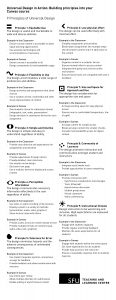| 1. Course Navigation |
| 2. Organizing Files |
| 3. Content Sustainability |
| 4. Prepare content for import/export |
| 5.Proofread content / leverage content visibility features |
| 1. Remove unused links from sidebar | 2. Pathways: limit students to minimal ways |
| 3. Post all assignments with details and use rubrics | 4. Use the dates with the native Canvas assignment tool |
| 5. Use rubrics | 6. Modules: organize by theme or weeks |
| 7. use a visual syllabus | 8. ensure that content is consistent |
| 9. access content through modules | 10. rename URL in files there are meaningful names and also dont use URLs as titles |
ldjdkdjdkdkladklklkdkdalk
| Collaboration Tools
· GoogleDocs · Etherpad · BB Collaborate · Voice Call · Vidyo/Skype/BlueJeans · Social Media · Canvas Spaces · Student Response Systems |
Assignments
· Different formats of submissions · Graphical representations · Use of different tools (mobile phone video, audio recordings, slide deck – powerpoint/prezi, pdf, visio, publisher, wireframe) |
Options for Communication
Zimbra SFU email, SFU maillist, Canvas mail, discussion boards, announcements, Instant Messaging, Social Media |
| Options for Recruiting Interest
· Provide choice and personal interest · Authenticity, relevance and value · Providing real life examples that are relevant and authentic. For example HBR case studies, current events/politics, drawing from student’s experience
|
Options for Perceptions
· Alternatives for auditory · Alternatives for visual · Alternatives to display information · Guide learners through processing, different medium of presenting information
|
Options for Physical Action
· Optimize teaching space for access · Allow various methods for response and navigation using various tools, communications methods |
- Canvas navigation
- Consider assessment methods
- Plain language
- Short and snappy
- Captioning and transcripts
- Multimedia integrations
- UDOIT (Canvas LTI )
Abstract: Higher Education learners have become diverse with a variety of learning needs and preferences in addition to those with documented disabilities. Canada, unlike the US, does not have national legislation for providing support and access for learners with disabilities. This article identifies universal design for learning principles applications and recommendations to support learners of all abilities including those with disabilities in face to face and online classes using Instructure Canvas LMS.
Keywords: Universal Design for Learning, Instructure Canvas, Instructional Design, Differentiated Instruction
